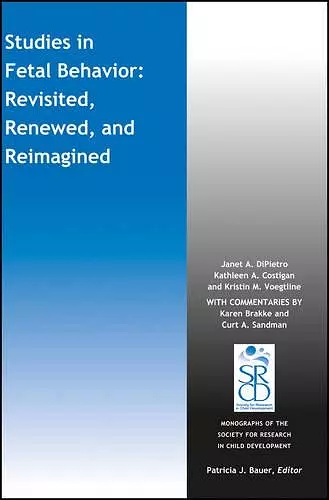Studies in Fetal Behavior
Revisited, Renewed, and Reimagined
Janet A DiPietro author Kathleen A Costigan author Kristin M Voegtline author Patricia J Bauer editor
Format:Paperback
Publisher:John Wiley and Sons Ltd
Published:20th Jul '15
Currently unavailable, and unfortunately no date known when it will be back

Among the earliest volumes of this monograph series was a report by Lester Sontag and colleagues, of the esteemed Fels Institute, on the heart rate of the human fetus as an expression of the developing nervous system. Here, some 75 years later, we commemorate this work and provide historical and contemporary context on knowledge regarding fetal development, as well as results from our own research. These are based on synchronized monitoring of maternal and fetal parameters assessed between 24 and 36 weeks gestation on 740 maternal-fetal pairs compiled from eight separate longitudinal studies, which commenced in the early 1990s. Data include maternal heart rate, respiratory sinus arrhythmia, and electrodermal activity and fetal heart rate, motor activity, and their integration. Hierarchical linear modeling of developmental trajectories reveals that the fetus develops in predictable ways consistent with advancing parasympathetic regulation. Findings also include: within-fetus stability (i.e., preservation of rank ordering over time) for heart rate, motor, and coupling measures; a transitional period of decelerating development near 30 weeks gestation; sex differences in fetal heart rate measures but not in most fetal motor activity measures; modest correspondence in fetal neurodevelopment among siblings as compared to unrelated fetuses; and deviations from normative fetal development in fetuses affected by intrauterine growth restriction and other conditions. Maternal parameters also change during this period of gestation and there is evidence that fetal sex and individual variation in fetal neurobehavior infl uence maternal physiological processes and the local intrauterine context. Results are discussed within the framework of neuromaturation, the emergence of individual differences, and the bidirectional nature of the maternal-fetal relationship. We pose a number of open questions for future research. Although the human fetus remains just out of reach, new technologies portend an era of accelerated discovery of the earliest period of development.
ISBN: 9781119186267
Dimensions: 229mm x 152mm x 9mm
Weight: 227g
316 pages
3rd edition